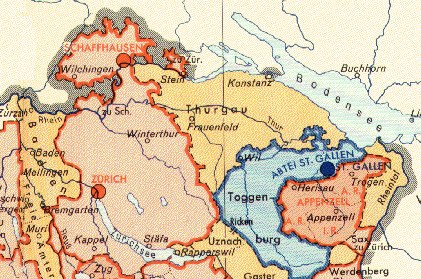He was now a genuine "Inspirationist" having
added their doctrines and peculiar bodily movements to his
own earlier belief in direct revelations. From this point on,
Giezendanner's work in Switzerland can be traced by the
excitement and conflicts, which his presence aroused in one
area after another. The northernmost canton of Switzerland,
lying on a direct line between Marburg and Giezendanner's
home in Lichtensteig, is Schaffhausen.
In September 1715, the church officials of that area appealed
to their superiors in Zurich for advice. Giezendanner had
arrived and had already won support among the younger
reform-minded clergy. The church leaders were advised to
exercise discipline over the young men and to urge them to
send Giezendanner on his way. After much hesitation they were
convinced that he should leave, and he headed toward home in
January 1716.
For the next few months, Giezendanner worked among
relatives and friends in Lichtensteig and the surrounding
area of Toggenburg. He preached, held meetings day and night,
spoke of revelations, and soon stimulated similar inspiration
and dreams in others. While these meetings were private and
did not require participants to give up their church
membership, Giezendanner himself seems to have severed his
connection with the church. Probably to avoid taking part in
the Pentecost communion service in Lichtensteig, he traveled
north to Bottighofen in Thurgau, just east of Konstanz on the
Bodensee. In Bottighofen the soil was already prepared. A
Swiss pastor who had lost his pulpit because of his pietistic
innovations had been holding secret meetings there for some
time, and the area seemed to draw other exiles from all parts
of east Switzerland. Giezendanner arrived and began
holding prayer meetings. He was soon joined by another ejected pietist
clergyman, Hans Georg Ungemuth.
next page